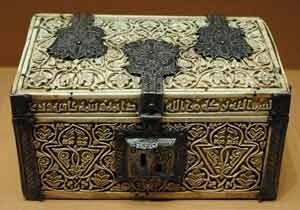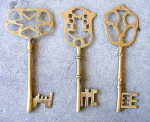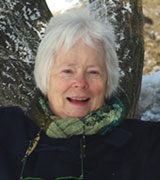
DIVING IN THE MOON
HONORING STORY, FACILITATING HEALING
The Golden Key: Wisdom from the Heart
© Mary Louise Chown
There is a snippet of a story in the Grimm’s collection about a boy who finds a golden key, and a mysterious casket which belongs with the key, but we are never told what is inside the casket. The tale ends (in the Jack Zipes translation) with these enigmatic words,
“...and now we must wait until he unlocks the casket completely and lifts the cover. That’s when we’ll learn what wonderful things he found.” *
What a marvelous tale, initially frustrating yet so full of sleeping images! When I came across this story during one of my leisurely bed time browses, in my mind’s eye I could see that boy and feel the rush of excitement and curiosity which propelled him to look further for the casket, and work to open it and reveal its contents. I thought how much more compelling it would be to hear the words of this tale falling upon the ear. What would others find inside the casket? I am always searching for stories that help to call forth associations and forgotten images, inviting listeners to look into their own life in order to finish the telling and I began to tell the story of The Golden Key at my art and storytelling workshops for adults and children.
 I told the story for the first time at a gathering of men in a group home for offenders where I was a visiting storyteller. Children were a forbidden topic for them as their offences were mainly against minors. For them, I changed the central figure to a man looking for firewood in the bush and the key that he found opened a box, instead of a casket. Most of the residents were native. They knew about the bush. More than half of Manitoba is a vast land of trees and water: a man could get lost there in the bush, or find his heart’s desire. When I finished the story, one of the men asked,
I told the story for the first time at a gathering of men in a group home for offenders where I was a visiting storyteller. Children were a forbidden topic for them as their offences were mainly against minors. For them, I changed the central figure to a man looking for firewood in the bush and the key that he found opened a box, instead of a casket. Most of the residents were native. They knew about the bush. More than half of Manitoba is a vast land of trees and water: a man could get lost there in the bush, or find his heart’s desire. When I finished the story, one of the men asked,
“Did he get it open?”
“Oh yes”, I replied.
When I asked them what they thought the man found in the box, there followed a flood of ideas; jewelry, pearls, skeleton bones, medicine (spirit) objects, a map, grass cuttings, another box inside with a small ring. Next, I asked the men what they thought the box looked like, and would they draw their idea for me? They all drew quite happily, taking great care. Some drew the contents of the boxes; coins, ceremonial pipes, leather pouches, while others drew an unopened box with a lid and keyhole. One box had wings drawn on either side, and it was surrounded by the woods. Another man drew a wolf standing in the midst of the trees, howling at a round shape in the sky above, mouth wide open and head flung back. Some part of the short tale had awakened this image, although he wasn’t able to tell me anything about it at that time. Like all of the other men present, he had never completed school, and had spent many years in foster and group homes. He found it very difficult to express his ideas in words. The beauty of linking storytelling with drawing is that explanations are not called for. All art imagery and story motifs are acceptable. There is no right or wrong answer or idea. There is just whatever happens.
Buoyed by my experiences with the men in the group home, I added The Golden Key to my repertoire of stories that I tell during my week-long school residencies, and the story changed again. This time it was about a brother and sister who are sent into the woods by their parents to look for firewood. Together they find the golden key and examine the casket, and take several tries at opening the lock. Sometimes there is a discussion between the two about the best way to try the key. Finally they feel the “click” of the key turning freely in the keyhole. It no longer satisfied me to ask merely,
“What does the casket hold?”
I became bolder and more demanding,
“Who put it there and why? What did the children do with the casket and how were their lives different? Why do you think such a short story was put in a book in the first place?”

I left in the word casket, because I love the sound of it. It may be unfamiliar to most children, but I have found that it doesn’t interfere with an understanding of the story: if anything it adds to the sense of mystery and magic. Magic is abundant in their artwork, in their answers to my questions, and in their stories. From an unruly grade six class there are paintings of maps and sparkling amulets, a snake curling out of a wooden casket, and a triumphant frog holding a shield! One painting is a bird’s eye view of the snowy woods, with the tiny figures of the boy and girl dwarfed by the bare winter trees. A class of ten to twelve year olds in a small rural school informed me that the story was short because,
“You look in your mind to see what happens next”
“You’re supposed to finish it yourself.”
In their stories about the golden key, students have told me about fabulous caskets which provide an endless supply of whatever was needed, or which have a hole inside leading to another world. Some contained nothing tangible, but were full of memories; others had letters left by a mother or a grandfather. The life of the brother and sister was always made better materially, or became more exciting when they entered another world via the casket.
When I first began my art and storytelling workshops, I hoped that participants would find many images to create from the stories I told them. I wasn’t expecting them to illustrate the story, rather to go back into the story in their own mind and find an image which summoned up the story for them. Then I would show them an art technique which they could use to make this idea come alive. Whenever I sensed someone having difficulty with this request, I would say,
“Pretend you can’t use any words because the person you’re telling the story to isn’t able to read. Can you draw one idea from the story?”
Now after two years’ experiences in the men’s group home, and three years of visiting schools throughout Manitoba, my program involves much more than merely drawing an image from a story. This activity was only a beginning, something to be done during my opening sessions. Later sessions ranged back and forth between art and storytelling as one idea led to another. Students began drawing and painting their own ideas, and recognizing common themes and motifs in all of the stories and the line between the two activities began to blur. Whenever I was able to work with a group for at least four or five one hour sessions, I became acutely aware of a change coming over the class group as soon as we gathered together. Bodies were relaxed. Eyes danced with expectation. It seemed as if an enchantment had settled upon us, an almost dreamlike state, yet more attentive. I no longer expected to accomplish a specific goal. Instead, the students and I began to share our lives through coming together to draw, paint, and hear stories.
I remember particularly the time I spent with a grade one class in a small town north of Winnipeg. I met with them for an hour each day all week long. Each day they came into the art room and settled themselves on the floor around me while I told them a story. Then we would talk for a little while. With minimal prompting, the children would tell me about the time they felt just the same way as someone in the story. On the first day, I told a story about a dream that Spider Anansi had, and for some reason the subject of death came up, although no death occurs in the story itself. Two children had lost fathers, while others remembered when an uncle or a grandfather died. One boy told me his mother was at that moment very sick in the hospital. His teacher told me later that she was not expected to live. When we moved to the art tables, I asked the children to cover their paper with large shapes of all their favorite colors, making sure that each color lay close to the next, until all the white of the page was gone. We had shared such deep feelings that I wanted them to be able to express them in color as well as words. As the children painted, they lost track of time, and even though their teacher and I reminded them that the session was nearly over, they found it very difficult to stop. Each day proceeded in much the same way until we came to our last session together.
 On this day I had decided to tell them the story of the Seal Woman. It deals with loss on several levels and seemed an appropriate tale to leave with them. I always hum a tune which is my “seal song” several times in my telling of the story. It comes for the first time when the fisherman hears the distant singing of the seals. I sing it next when the children find the hidden sealskin, and then again at night when the seal mother tells her children stories about the sea. After she has gone, both father and children hear it whenever they are near the sea. I never teach the “seal song” as it is not a sing – along type of melody. I was stunned when these grade one children just opened their mouths as if they couldn’t help themselves, and hummed along whenever I sang. Their notes were in perfect harmony with my song and their voices gradually faded away each time mine did. One child whistled softly. I felt that I was hearing echoes from angels. When the story ended we all sat there in silence, hardly breathing. Then we all let out one great sigh in unison. I still treasure the memory of that moment and the immense sense of well being that was present in that room. By some strange coincidence, their teacher’s name happened to be Mr. Merlin!
On this day I had decided to tell them the story of the Seal Woman. It deals with loss on several levels and seemed an appropriate tale to leave with them. I always hum a tune which is my “seal song” several times in my telling of the story. It comes for the first time when the fisherman hears the distant singing of the seals. I sing it next when the children find the hidden sealskin, and then again at night when the seal mother tells her children stories about the sea. After she has gone, both father and children hear it whenever they are near the sea. I never teach the “seal song” as it is not a sing – along type of melody. I was stunned when these grade one children just opened their mouths as if they couldn’t help themselves, and hummed along whenever I sang. Their notes were in perfect harmony with my song and their voices gradually faded away each time mine did. One child whistled softly. I felt that I was hearing echoes from angels. When the story ended we all sat there in silence, hardly breathing. Then we all let out one great sigh in unison. I still treasure the memory of that moment and the immense sense of well being that was present in that room. By some strange coincidence, their teacher’s name happened to be Mr. Merlin!
It has taken me some time to comprehend the magnitude of the experiences that I’ve been privileged to share, and that I have also been responsible for setting in motion at each school visit. I had offered storytelling and art making without any real appreciation of their combined strength and power. They were simply the two activities which I enjoyed doing and felt confident that I could handle in a workshop. I did not expect to shiver with wonder when others sank into enjoyment upon hearing a story, or revel in the power they had to make marks on previously blank paper.
Now I’m beginning to understand what has been happening. I have been giving my listeners their own Golden Key and inviting them to look deep into the richness of their inner lives, into their imagination. These riches are not material things and at first may be as fleeting as a passing thought, or as elusive as a daydream. But they must be held in our waking consciousness from time to time so that we can redefine and reinvent ourselves and discover where we fit in the “real” or outer world.
 Art is one way of releasing and grounding the creative energy which comes when imagination is awakened. I have found this to be especially true for young children and for those who have difficulty with the written word. One stroke of the crayon or sweep of the paintbrush sets in motion an almost visceral experience; a chain of actions where line or color builds one on another and allows one to create a new vision of life which did not exist in quite this way before.
Art is one way of releasing and grounding the creative energy which comes when imagination is awakened. I have found this to be especially true for young children and for those who have difficulty with the written word. One stroke of the crayon or sweep of the paintbrush sets in motion an almost visceral experience; a chain of actions where line or color builds one on another and allows one to create a new vision of life which did not exist in quite this way before.
Hearing a story is like listening to music, the words falling off the teller’s tongue, onto our ears, and into our heart. We seem to have no defense against them, being unable to exert any control over the memories or thoughts that they set in motion. Stories are heard in the deep heart’s core and answer the burning questions which we all have. Who are we? Where did we come from? Who do we love? What have we forgotten that is important to remember? Why is there goodness and evil in the world? Why is there something rather than nothing? The answers which are the most meaningful come, in the end, from deep within our own selves.
* Jack Zipes trans. The Complete Fairy Tales of the Brothers Grimm vol. 2, p.288, Bantam Books, 1987

 Mary Louise Chown has taken storytelling in many innovative directions from her base in the Manitoba storytelling community. She co-founded the Manitoba Storytelling Guild, was artistic director of the Magic of One Concert series, and served as the first Storyteller-in-Residence at the Winnipeg Public Library. With drum, hammered dulcimer, and a close attention to the music of language, she demonstrates a creative approach to storytelling as a performing art, often collaborating with Canadian and International musicians. Teacher, hospice storyteller, and visual artist, Mary Louise has performed at storytelling festivals across Canada and in Australia and Great Britain, on CBC radio, and at the Winnipeg Folk Festival. She now tells stories from her farm in rural Manitoba, where she has become known as the River Hills Raconteur.
Mary Louise Chown has taken storytelling in many innovative directions from her base in the Manitoba storytelling community. She co-founded the Manitoba Storytelling Guild, was artistic director of the Magic of One Concert series, and served as the first Storyteller-in-Residence at the Winnipeg Public Library. With drum, hammered dulcimer, and a close attention to the music of language, she demonstrates a creative approach to storytelling as a performing art, often collaborating with Canadian and International musicians. Teacher, hospice storyteller, and visual artist, Mary Louise has performed at storytelling festivals across Canada and in Australia and Great Britain, on CBC radio, and at the Winnipeg Folk Festival. She now tells stories from her farm in rural Manitoba, where she has become known as the River Hills Raconteur.
